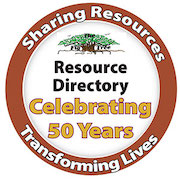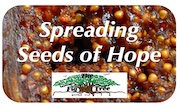Native Non-Native Talking Circle fosters understanding, relationships
 |
| Debbie Stempf, Agnes Broncheau and Henry Broeckling share their experiences in the talking circle. |
For two years, three to 40 people have met monthly for the Native Non-Native Talking Circle of Spokane. The circle is a project of One Peace Many Paths, an organization that focuses on building bridges of peace and compassion among diverse peoples.
When Henry and Joan Broeckling, members of Unity Spiritual Center and leaders of One Peace Many Paths, had a Native American woman live with them for a year to help her with healing and prevent her from being homeless, their eyes were opened to the gap between native and non-native cultures.
Agnes Broncheau, with the Nez Perce Tribe or Niimiipuu, helped them form the talking circle along with Debbie Stempf.
They seek to model what happened when native and non-native people in the Twisp-Methow area began to meet in 1999. Their story of healing and relationship is documented in the film, “Two Rivers.” The Spokane group began by showing that film about Glen Schmekel, a school executive, and his wife, Carolyn, an interior designer, who moved from California to the confluence of the Twisp and Methow rivers. Sensing a presence on their land, they connected with the Methow Tribe, who had once lived there.
The movie tells of discovery, connection and reconciliation among Native and European Americans as they learned what is not in history books, the story of the Methow culture being disrespected, values trivialized and beliefs demonized. Methow children were torn from families to attend white-run boarding schools where they experienced abuse that led to poverty, alcoholism and suicide for some, Henry said.
In 2003, that group made their reconciliation public, drawing other white townspeople and reservation people to a powwow to address historic native grievances. Native people were again able to harvest sacred medicinal plants and food from local ranches and farms, and to integrate Methow culture into the school curriculum.
There is a Reconciliation Powwow every year. The Spokane group attended in 2014.
After seeing “Two Rivers,” Agnes realized the reconciliation experienced there would be hard for Spokane, where there are many people of many tribes.
For example, Talking Circle participants include an Assiniboine from the Fort Peck Tribe, a Sioux from the Pine Ridge Reservation and a Ute from Utah.
“We are different tribes, meeting in a safe space to share that brings healing,” Agnes said.
The Spokane talking circle meets at Emmanuel Family Life Center to share and hear stories.
“When native people share about Catholic mission schools and ways the U.S. government destroyed our culture, it’s the first time some white people hear that and apologize,” Agnes said. “As I share what happened to us, more and more I experience healing.”
To foster healing, she often does a smudging ritual, burning bundled sage, before meetings.
Henry said that as participants enter into intentional listening to learn what happened in the past, they find listening is “a powerful force for healing for everyone.”
At meetings, people gather in an opening circle for prayer and introductions. Then they eat. The program is sometimes a movie or speaker, and often includes group discussions and sharing.
In March, Carol Evans, chair of the Spokane Tribe, and David Brown Eagle, vice chair, said they had not realized they were salmon people, because dams blocked the fish. They also told of the tribe’s commitment to help the City of Spokane restore the water quality of the Spokane River.
They support the group’s sharing stories and honoring each other.
“Many support bringing salmon back. When that happens, I believe people will heal. If we address the losses people endured, we will heal,” Carol said.
The Native Non-Native Talking Circle and One Peace Many Paths are helping Upper Columbia United Tribes clean up Drumheller Springs Historical Park, a traditional gathering place in West Central Spokane on Ash Pl. at Euclid Ave. They seek to restore it as an oasis of native plants.
“We create opportunities to serve, as well as talk,” said Henry, an instructional assistant at Chase Middle School.
He moved to Spokane with his wife in 2007. They lived in Seattle and Edmonds for 30 years. He’s from an Illinois farm town with German roots.
Debbie, whose heritage is German, too, said that like many European Americans, she does not know her family’s roots. She said she is involved in the group because she is committed to be an earth keeper.
“We need to come together for the earth,” she said.
Debbie, who grew up in Minneapolis, Minn., first became interested in Native Americans in the 1970s, through Dennis Banks and Russell Means of the American Indian Movement (AIM). In 1976, she moved to Seattle and in 2008 to Spokane, where she is a physical therapist.
“I have experienced a deepening of what I had known about what happened. I felt helpless about what to do to rectify what happened,” she said. “Stories of the AIM were buried in newspapers. This experience is building bridges and friendships.”
Agnes, who grew up in Lapwai on the Nez Perce reservation, has lived 20 years in Spokane and recently celebrated 29 years of sobriety.
She tells of her heritage to educate people, so “we will no longer be invisible” and so people will respect the people on whose land they live.”
When she was at a government boarding school, she said she lost her identity. Her hands were slapped with a ruler when she didn’t speak English or struggled with math, but she learned her heritage because her family kept a family tree that goes far back so cousins would not intermarry.
She knows fear can lead to running away or facing people and recovering. Once she turned her life around and raised six children, she began studying social work at Eastern Washington University.
She found both English and math hard to learn because of the abuse in school.
Her path at EWU was hard and took her nine years from 2003 to 2012. She had to complete logic as a substitute for the math requirement and prove English is her second language. Niimiipuu is her first. The Center for Justice helped advocate for her.
“Being with non-Native people reminds me of my foster family. It helps when non-natives acknowledge the abuse at boarding schools and from government bureaucracy.
“We survive because we persevere,” she said, adding, “in 2010, after years, I finally received a folder with information on my life at a children’s home.
“My father said to let sleeping dogs be, but I believe healing comes by knowing truth. Some wounds we can’t do anything about, but we need to know about them,” Agnes said.
Henry said healing for him comes in recognizing what Native Americans experienced. Now he understands the woman who lived in his home.
“I have opened my heart to Native Americans and how the U.S. government took their land, cut them off from their culture and executed many,” he said.
To Agnes, the European-American participants are brave.
Some native sisters wonder why she “hangs with” European Americans.
“I tell them we need to forgive, learn to become allies and stop hating,” she said. “Many Natives are not healed. Families, who relocated to the city, do not know their songs, culture, drums or regalia as they assimilated to city life. I invite them to join us and heal. The healing comes like peeling layers off an onion.”
Debbie said, “We are all looking to find ourselves, to find who we truly are with everyone else.”
Upcoming circles are a video, “Black Indians: An American Story” at 6 p.m., Tuesday, May 17, and Native drumming and singing onTuesday, June 21.
For information, call 536-2811, or email niimiipuu2000@gmail.com or dstempf@comcast.net.
Copyright © May 2016 - The Fig Tree






